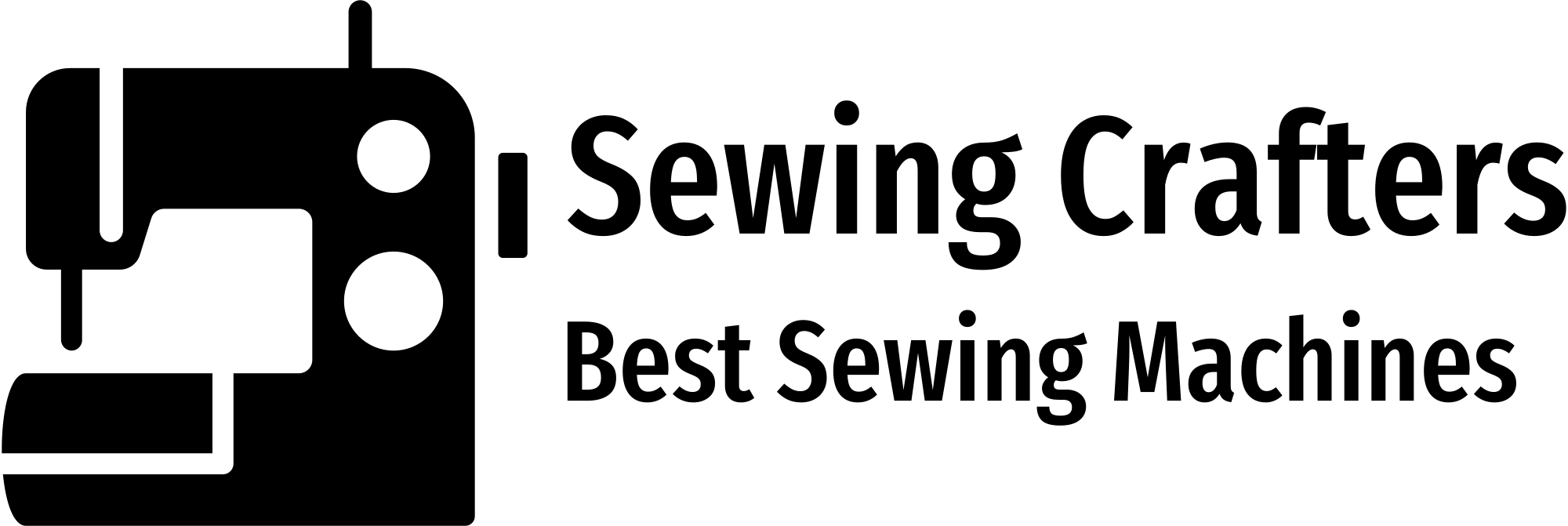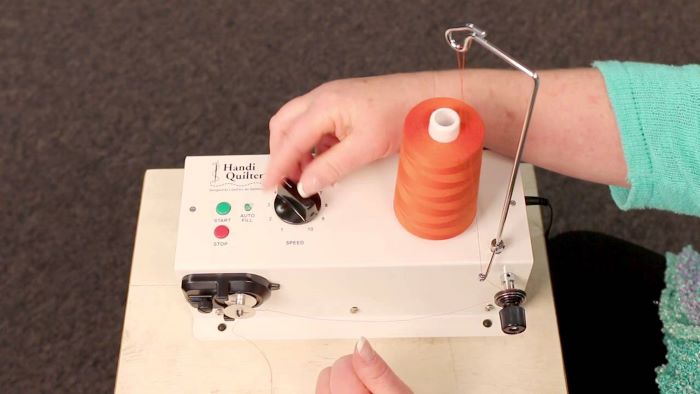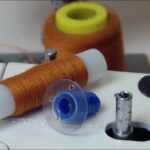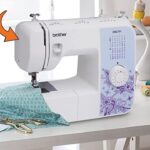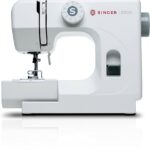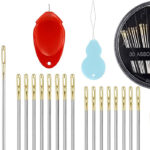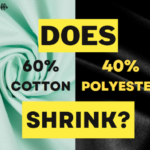If you’re a quilter, you know how important it is to have a reliable and efficient bobbin winder. The Handi Quilter Bobbin Winder is one of the most popular and trusted options in the market today. In this article, we’ll explore the Handi Quilter Bobbin Winder in detail, including its features, benefits, and how to use it.
The Handi Quilter Bobbin Winder is a standalone bobbin winder designed specifically for quilters. It comes with all HQ machines and can wind up to 40% faster than traditional winder methods. It’s a high-quality and durable tool that can save you time and improve the efficiency of your quilting process.
The Handi Quilter Bobbin Winder comes with several features that make it stand out from other bobbin winders in the market. These features include:
You can use almost all types of bobbins on Handi Quilter Bobbin Winder. The start and stop button enables you to manually start and stop the winder. The built-in sensor automatically stops the winder when the bobbin is full.
This bobbin winder can wind up to 40% faster than traditional winder methods, saving you time and improving the efficiency of your quilting process. The speed control button on the Handi quilting bobbin winder helps to control the speed of the motor. I recommend using medium speed not too slow or too fast.
The Handi Quilter Bobbin Winder is made of high-quality materials that make it durable and long-lasting. It can withstand regular use and last for many years. This gadget is made for quilters who need bobbins with different colors for the same project.
The tension on the bobbin winder is adjustable, allowing you to wind bobbins to the perfect tension for your specific project.
If you are a quilter then you must read this post on How to Transfer Thread from Cone to Spool: A Comprehensive Guide
Using the Handi Quilter Bobbin Winder can provide several benefits to quilters. Some of these benefits include:
The HQ Bobbin Winder can wind bobbins up to 40% faster than traditional winder methods. This can save you time and help you complete your quilting projects more efficiently. In quilting, you may need to frequently change the thread color. With a handi quilter bobbin winder, you can wind bobbins with different colors.
The adjustable tension on the bobbin winder ensures that all bobbins are wound to the same tension, resulting in more consistent and even stitching.
The Handi Quilter Bobbin Winder produces high-quality bobbins that are evenly wound, resulting in less thread breakage and better stitch quality. HQ bobbin winder is specially designed for quilters.
Before you learn how to use the HQ bobbin winder you must know about the main part of the winder. Here are the parts of a Handi Quilter bobbin winder. These are the basic parts of a Handi Quilter bobbin winder. Depending on the specific model, there may be additional parts or features.
Handi Quilter Bobbin Winder
- Bobbin Winder Spindle: This is the metal rod that holds the bobbin while it is being wound.
- Bobbin Winder Stopper: This is a small plastic piece that fits onto the end of the bobbin winder spindle. It helps to hold the bobbin securely in place during winding. It automatically stops the bobbin winding process.
- Bobbin Winder Tension disc/plate: This is a small metal disc or plate. It provides tension on the thread as it is being wound onto the bobbin. This tension is responsible for even winding of the thread.
- Thread Guide: This is a small plastic or metal hook that helps guide the thread onto the bobbin during winding or to the tension disc/plate.
- Bobbin Winder Motor: This is the motor that powers the bobbin winder spindle to wind the thread onto the bobbin.
- On/Off Switch: This is a switch that turns the bobbin winder motor on and off.
- Speed Control: This is a dial or switch that controls the speed of the bobbin winder motor.
- Power Cord: This is the cord that connects the bobbin winder to a power source.
Using the Handi Quilter Bobbin Winder is easy and straightforward. Here’s a step-by-step guide on how to use it:
The first step is to set up the HQ bobbin winder. In this step assemble all the parts of the winder and make it ready to use. The main parts of the bobbin you may need to assemble are a thread post, thread mask, thread guide, DC adopter, and power cord.
Place the cone or spool of thread on the thread post assembled earlier. Take the thread from the cone up over the loop and then down to the thread guide. The thread is then passed from the tension plates. In the video below you can see all the steps explained to thread the HQ bobbin winder sewing machine.
Place your empty bobbin onto the spindle of the bobbin winder. The thread coming from the tension plates is winded on the bobbin.
Press the start button to start winding the bobbin. Adjust the tension as needed to wind the bobbin to the desired tension.
Once the bobbin is fully wound, remove it from the spindle and trim the thread. Your bobbin is now ready to use. If you will not stop the winder it will automatically stop due to the presence of the sensor.
Keeping your Handi Quilter Bobbin Winder clean and well-maintained is crucial to its longevity and performance. Here are some tips on how to clean and maintain your bobbin winder:
Use a soft cloth to wipe down the bobbin winder after each use. This will help prevent dust and debris from building up and affecting the performance of the winder.
Use a small amount of machine oil to lubricate the moving parts of the bobbin winder regularly. This will help keep the winder running smoothly and prevent it from jamming.
If you notice any parts of the bobbin winder are worn or damaged, such as the spindle or tension knob, replace them immediately. Using a damaged bobbin winder can affect the quality of your stitching and cause other issues.
When not in use, store the bobbin winder in a clean, dry place. Avoid exposing it to extreme temperatures or direct sunlight, as this can damage the components of the winder.
If you are interested in Handi Quilter bobbin winder then you must read How to Use Automatic Bobbin Winder: A Step-by-Step Guide.
Until now I did not face any issues with the handi quilter bobbin winder. However, I can provide some general information on common problems people may face while using bobbin winders. With a little effort, you can overcome all these problems.
Tension issues: If the tension is not set correctly, the thread may wind too tightly or too loosely around the bobbin. This can lead to issues with the stitching and cause the thread to break or become tangled.
Bobbin size compatibility: Make sure that the bobbin winder is compatible with the size of the bobbins you are using. Using the wrong size can cause the bobbin to wind unevenly or even damage the winder.
Winding speed: Be mindful of the winding speed. If the speed is too high, the thread may wind unevenly or cause the bobbin winder to overheat. If the speed is too low, the bobbin may not wind tightly enough.
Tangled thread: Occasionally, the thread may become tangled or caught in the bobbin winder. This can be caused by a variety of factors, such as using old or low-quality thread, improper tension, or a dirty bobbin winder.
Bobbin winding too loosely or too tightly: If the bobbin is wound too loosely, it can cause issues with the stitching and may even cause the thread to jam. If the bobbin is wound too tightly, it may not fit properly in the bobbin case, causing issues with the stitching.
The Handi Quilter Bobbin Winder is an essential tool for any quilter. It’s durable, efficient, and can save you time and improve the quality of your stitching. With adjustable tension and compatibility with all longarm quilting machines, the Handi Quilter Bobbin Winder
Yes, the Handi Quilter Bobbin Winder is compatible with all long-arm quilting machines.
The HQ Bobbin Winder can wind bobbins up to 40% faster than traditional winder methods.
The tension on the Handi Quilter Bobbin Winder is adjustable. You can adjust the tension knob on the winder to wind bobbins to the desired tension.
It’s recommended to clean and maintain your Handi Quilter Bobbin Winder after each use. Regular lubrication and replacing worn or damaged parts are also important for maintaining the performance of the winder.
Yes, the Handi Quilter Bobbin Winder can be used for other types of sewing projects besides quilting. It’s a versatile tool that can wind bobbins for any type of sewing machine.
